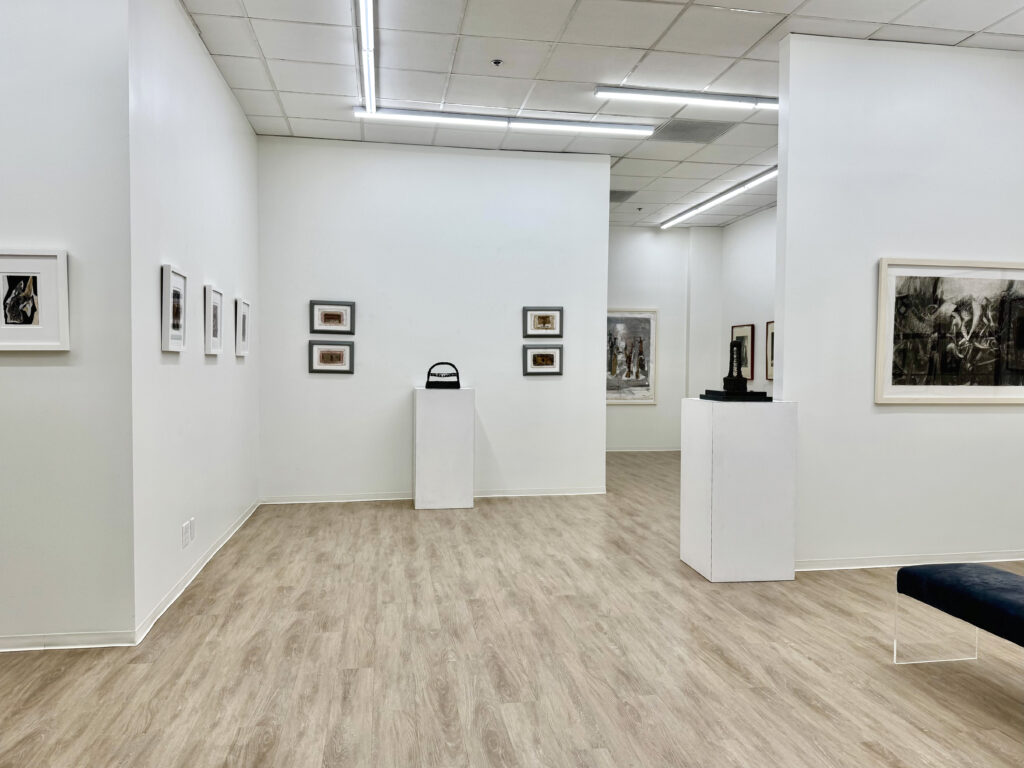In a world where bigger often seems better, artist George Nama has spent 60 years pursuing a different path. His early painted collages from the late 1950s—a period when abstract expressionists were exploding onto massive canvases—are deliberately small, achieving what gallery director Jack Rutberg calls “monumental scale in an intimate format.”
“What you see here are some very small painted collages from the fifties that if one was just seeing an image, one might think it’s a large painting,” says Rutberg, whose Pasadena gallery, Jack Rutberg Fine Arts, is currently showcasing “George Nama: 60 Years of Selected Works” through May 17.
The exhibition offers a comprehensive view of Nama’s artistic journey, from those early collages to bronze sculptures, painted works on antique music sheets, and the exquisite etchings for which he has earned international acclaim.
“George Nama is an artist that emerged out of the kind of surrealist movement that gave life to American abstract expressionism,” Rutberg explains. “The works have representational aspects, but they’re invented forms. These are out of the imagination and a very, very extraordinary etcher.”
Throughout the thoughtful and intimately arranged gallery, Nama’s bronze sculptures stand like mysterious artifacts. They are “completely out of the imagination, invented forms that look both ceremonial, architectural and cultural,” notes Rutberg. “They feel like they might’ve been dug up out of a historic site.”
What distinguishes Nama’s career beyond his visual innovations is his extensive history of collaborations with some of the 20th century’s most significant cultural figures. The artist has worked closely with celebrated French poet Yves Bonnefoy, American poet laureate Charles Simic, and renowned pianist Alfred Brendel, creating works that respond to and inspire their writings.
“It’s a tradition that carries forth since the late 19th century where great literary figures inspired visual artists and those collaborations were born,” Rutberg says. These partnerships have produced what Bonnefoy himself described as being “among the most remarkable creations in the past twenty to thirty years, in the United States or France, where the genre has a long tradition.”
Among the exhibition’s many notable pieces is a series titled “Liberator,” a collaboration with filmmaker George A. Romero, creator of the influential horror classic “Night of the Living Dead.” The two Georges had been friends since their school days at Carnegie Institute in Pittsburgh.
“Romero became such a remarkable figure for having been both a pioneer of the horror genre for many reasons,” says Rutberg, noting that “Night of the Living Dead” featured a Black protagonist during the civil rights era, giving it “a moral tone.” Years later, after seeing Nama’s other literary collaborations, Romero wrote a poignant short story specifically to accompany Nama’s etchings.
Due to copyright complications following Romero’s death in 2017, the story can now only be read on the walls of Rutberg’s gallery—an unexpected literary footnote to the exhibition. “It cannot be published widely due to copyright scenarios and complexities,” Rutberg explains.
Many of Nama’s works incorporate antique music sheets beneath layers of paint and collage elements—a technique that Rutberg sees as emblematic of the artist’s approach. “It’s a way of connecting to culture, that history is beneath and inspired virtually everything going forward,” he says.
This sense of cultural connection extends to Nama’s remarkable etchings, which Rutberg describes as “tour de force.” With their extraordinary tonal range, these black and white works evoke comparisons to Rembrandt. They depict what Rutberg calls “gardens of sculpture”—invented landscapes populated by Nama’s abstract figures.
For Rutberg, whose gallery has long showcased museum-quality exhibitions, selecting artists for his space is driven by both personal passion and artistic merit. “One of the challenges is also one of the joys, and that is I get to do what I want to do,” he says with a smile.
He looks for artists with “unique visions” who have made an impact and continue to “evoke other people’s imaginations.” The bar is deliberately high. “Great art is always decorative. It has an impact in one’s environment,” Rutberg notes, “but above all the substance of the work, the ideas behind it, be it sheer joy or poignancy, it has to be evocative in my view.”
Nama’s works certainly meet this standard, residing in major museum collections worldwide including the Smithsonian Institution, the Metropolitan Museum of Art, the Morgan Library, and the Los Angeles County Museum of Art, among many others.
As viewers move through the exhibition, they experience the full breadth of an artist who has spent six decades creating work that defies easy categorization—at once monumental and ephemeral, figurative yet invented, deeply personal yet connected to a broader cultural conversation spanning continents and artistic disciplines.
Jack Rutberg Fine Arts
600 South Lake Ave., #102 ∙ Pasadena, CA 91106 ∙ Tel (323) 938-5222
jrutberg@jackrutbergfinearts.com — www.jackrutbergfinearts.com
Gallery Hours: Tues – Fri: 10:00 to 6:00 & Sat: 10:00 – 5:00
Gallery Entrance Though Lobby
Free Parking Entry on South Lake Avenue


